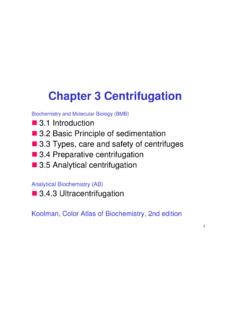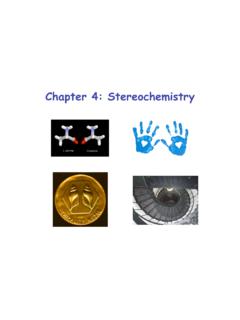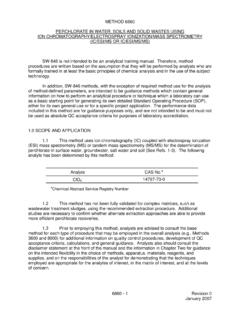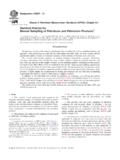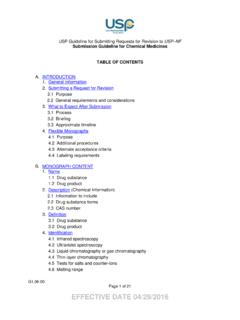Transcription of Gas Chromatography in Environmental Analysis 1.0 …
1 Environmental Instrumentation Handbook Driscoll, JohnEnvironmental Instrumentation Handbook Wiley (2004) CH 8 1 Gas Chromatography in Environmental Analysis Introduction This chapter is written from the perspective of an Environmental professional. It focuses on those aspects of Gas Chromatography that aid in the selection of instrumentation and columns for both field and laboratory methods. In addition, it should be a useful resource for anyone who is responsible for interpreting data collected in the field. We start by describing the theory of gas Chromatography (GC), then we discuss the selection of columns, gas solid and gas liquid Chromatography , phases, packed and capillary columns. This material is intended to provide the reader with sufficient information to select a proper column for Analysis of a particular site or a difficult sample.
2 In the next section, we describe the hardware required for GC. The fourth section describes the need for good temperature control even for field GC s. The GC detectors that are described include the photoionization detector (PID), the flame ionization detector (FID), the thermal conductivity detector (TCD), the electron capture detector (ECD), the far UV absorbance detector (FUV) and the flame photometric detector (FPD). For each detector, the theory of operation, the range, detection limits and characteristics are described. Individual species can be measured from ppt to % levels with either a specific or universal type detector. Finally, we discuss the Analysis of volatile organic (VOC) and semivolatile (SVOC) compounds, dual detectors (PID/FID), headspace, as well as concentrators for GC s that can be used for monitoring low or sub ppb levels of toxic species at the fenceline.
3 Gas Chromatography Theory Gas Chromatography (GC) is a method of continuous chemical separation of one or more individual compounds between two phases. One phase remains fixed (stationary phase); the other, the mobile phase (carrier gas), flows over the stationary phase. The components enter the stationary phase simultaneously at the injector but move along at different rates. The lower the vapor pressure of the compound (higher boiling point), the longer the compound will remain in the stationary phase. The time that each compound remains in the stationary phase depends on two factors: the vapor pressure of the compound and its solubility in the stationary phase. These compounds are then detected at the end of the column. A plot of the output of the detector response versus time is termed a chromatogram.
4 Elution times may be reduced by increasing the temperature of the GC oven. GC s can be run isothermally (constant temperature) to separate a narrow boiling range of solutes. If the separation of low and high boiling compounds is necessary, temperature programming (linear increase of column temperature) is used. The Retention time is defined as the time measured from the start of injection to the peak maximum and can be used to identify resolved components in mixtures. The times measured as RT1, RT2, RT3 shown in Fig. 1 would be the retention times for components A1-A3. The retention time is characteristic for a compound and the stationary phase at a given temperature and is used for identification when the mixture of compounds is completely resolved. To confirm that a particular component is present requires the identification on two columns with different polarities of stationary phases.
5 Some Environmental methods allow confirmation of compound identity by comparing both retention times and detector response factors with known standards. Instruments that are configured for either dual columns with a single detector, or a single column with dual detectors (PID/FID) can combine Analysis and confirmation in a single run. Dr. Jack Driscoll, PID Analyzers, LLCGas Chromatography chapter Driscoll, John N. Environmental Instrumentation Wiley ( 2004) Ch 8 2 Figure 1. Column Selection- There are a large number of GC packings available. Each of these exhibit specific retention characteristics for specific compounds. Many times, a better separation is obtained more easily by changing the liquid phase than by increasing the length of the column.
6 A properly made capillary column of 5M in length will have about 12,000-15,000 plates effective plates, more than 100 times the resolving power of a short packed column. Interesting enough, with all of the developments in capillary column technology, at a recent symposium (1), one researcher was still talking about the utility of short, packed columns at ambient temperature. With the minimum of separating power (efficiency), many peaks could still be unresolved under a single peak. A comparison of packed and capillary columns is shown in Table I. Table I Comparison of Packed and Capillary Columns Parameter Packed Capillary Length (meters) 5-100 ID (mm) 2-4 Flowrate (ml/min) 10-60 Total plates (length M) 5000 (2 M) 75,000 (25M) Film thickness ( ) 1-10 Methyl silicone stationary phase is considered non-polar generally eluting compounds in boiling point order.
7 When polar functional groups are added in stationary phase. The Number of theoretical plates is a term taken from chemical engineering originally used to describe the efficiency of a distillation apparatus. This theory was applied to columns in gas Chromatography to describe the efficiency (separation ability) of a column. Separation occurs as a result of continuous movement between the stationary phase and the mobile phase Clearly, the larger the number of plates, the greater the resolving power of the column. Number of theoretical plates (n) is given by: n = (t/w)2 Where t= retention time; w = peak half hight Number of effective theoretical plates (Neff) is given by: Neff = (t'/w)2 t = adjusted retention time = t tm ; tm = retention time for inert peak like methane Height equivalent to a theoretical plate (h) is given by: h = L/n Where L= length of column Gas Solid Chromatography - GSC Solid packings are generally used to separate gases and compounds with boiling points below propane.
8 Polymers which are derivatives of styrene divinyl benzene, cross linked acrylic ester, cross linked polystyrene etc. are small particles with pores and variable surface areas. These porous polymers are available in a variety of polarities for specific separations of low molecular weight compounds (methane, ethane, ethylene, H2S). It would be difficult to analyze ethylene (gas) and benzene (very long retention time) on these porous polymers and similarly, it is difficult to analyze ethylene on a short (5M) capillary column since it would be an unretained (would elute very quickly) compound. Zeolytes or molecular sieves that employ size exclusion for separation. Certain molecules that are small enough to enter the pores exist the stationary phase exit the stationary phase later than larger molecules that cannot enter the pores Gas Chromatography chapter Driscoll, John N.
9 Environmental Instrumentation Wiley (2004) Ch 8 3readily. These phases are commonly used for the separation of permanent gases (including O2 and N2). Gas Liquid Chromatography - GLC Columns with liquid stationary phase are generally used to separate compounds with boiling points above propane (C3H8). More that 70% of all separations in gas Chromatography can be accomplished with a methyl silicone liquid phase (OV1, OV101, SE30). However, there are more than 1000 packed column liquid phases available attesting to their versatility for specific separations. Types of column phases The stationary phase is most influential column parameter since it determines the final resolution and has an influence on the sample capacity and the Analysis time.
10 The most important thing to remember is that likes dissolve likes". Separate non polar compounds on a non polar column and polar compounds on a polar column. In Fig. 2, the range of polarity of a group of organic compounds is compared with the polarity of different phases. Fig. 2 Polarity of Compounds and Phases In other words, if one has non polar hydrocarbons to separate, use a non polar phase like (SE30, NBW30); with more polar compounds like alcohols, esters use a polar phase like carbowax, etc. The data in Table II lists the optimum liquid phases on a packed or capillary column for a variety of analytes. The terminology in Table II is the of Ohio Valley Specialities (OV). These silicone phases in order of polarity are least polar (OV1, OV101), medium polarity (OV1701), and most polar (OV275).




